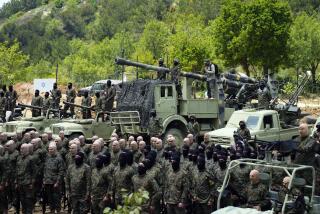Libya rebels scrambling to secure Kadafi arsenals
- Share via
Reporting from Tripoli, Libya — The fall of Moammar Kadafi has opened up Libya’s vast armories to plunder and pillage, causing alarms to sound worldwide about the possibility that terrorists or insurgents may gain access to lethal weapons, including mines, mortars and missiles capable of shooting down civilian airliners.
Officials of the rebel leadership here say they are scrambling to secure Kadafi’s arms stockpiles, but the sites are so numerous that the task is overwhelming. And securing the weapons is only one of many grave challenges facing them.
“We are doing our best, but we are extended to the limit,” said Jalal Gallal, a spokesman for the interim administration here. “Some of these places are being found on an hourly basis. It’s all-consuming. It is one of the legacies we have from Kadafi.”
Weapons depots often turn up in unexpected places: homes, commercial strips, school property. The caches were a major supply source for Libya’s rebels, who overran many stashes and helped themselves, often welding weapons systems to pickup trucks and slapping on homemade metal plates for armor.
As a NATO-led alliance unleashed its bombing campaign in March, experts say, the Kadafi regime began moving the weapons from known military outposts, shifting many of them to civilian sites. The migration of arms has greatly complicated the task of securing them.
At a sprawling base on the southern fringes of Tripoli, piles of rubble attest to the damage from airstrikes on what once was a headquarters of the much-feared 32nd Brigade commanded by Kadafi’s son Khamis. A giant sculpted eagle, a symbol of Kadafi’s power, stands at the entrance, above a thick metal door blasted to pieces as rebels assaulted the base.
At some point, it appears, Kadafi’s military transferred massive stores of armaments across the street to a mixed commercial-residential strip and a nearby government printing complex.
It was here that investigators for Human Rights Watch say they found documents, empty boxes and other evidence of hundreds of missing Russian-made surface-to-air missiles, much cherished on the international black market. Security experts cringe at the thought of terrorists getting hold of such weaponry, including the SA-7 and the more sophisticated SA-24, which is capable of taking down an aircraft at 11,000 feet.
“This kind of missile could turn all of North Africa into a no-fly zone,” said Peter Bouckaert, emergencies director for Human Rights Watch.
It does not appear that the missiles found so far in Libya can be shoulder-fired, making them less of a terrorist threat, experts said. The weapons must be fired from a launcher mounted on a vehicle. But the proliferation of such armaments remains a major concern.
Many reports have indicated that Libyan arms may have already filtered into neighboring Algeria and Niger, and possibly other African nations where militant groups are active.
At a news conference Thursday in Algiers, the Algerian capital, the top U.S. military commander in Africa, Gen. Carter Ham, cited the danger of Libyan weapons slipping across borders.
“There is a threat of the proliferation of the weapons from Libya and we are greatly concerned — all the nations are very concerned — about small weapons, rifles and weapons similar to that, but also explosives and shoulder-fired air defense systems,” the news agency Agence France-Presse quoted Ham as saying.
Iraq, too, was awash in unsecured weapons after the U.S.-led invasion in 2003. Its conventional arsenal provided the raw material for the roadside bombs that became the insurgency’s signature weapon and killed many U.S. troops.
Some worry that such a scenario could play out in Libya as well if Kadafi loyalists mount a guerrilla war against the nation’s new rulers. Down the road from the compound that housed the missing surface-to-air missiles is a commercial building that contains more than 100,000 anti-tank and anti-personnel mines.
Rebel troops were summoned to guard the building after news reports of the cache. Littering the ground outside were wooden boxes of what appeared to be anti-tank mines, although one rebel guard said he thought they were torpedoes.
“These are the kinds of explosives that can be turned into car bombs, suicide vests and improvised explosive devices,” said Bouckaert of Human Rights Watch, who was visiting the site Thursday. “For the Libyan people, that’s a major concern. Unfortunately, a lot of the worst things have already walked away.”
More to Read
Sign up for Essential California
The most important California stories and recommendations in your inbox every morning.
You may occasionally receive promotional content from the Los Angeles Times.










